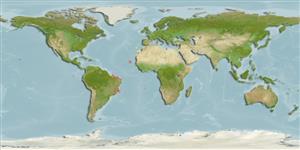Actinopterygii (ray-finned fishes) >
Perciformes (Perch-likes) >
Scaridae (Parrotfishes) > Sparisomatinae
Etymology: Sparisoma: Latin, sparus = a fish with a golden head + Greek, soma = body (Ref. 45335).
Environment / Climate / Range
Ecology
Marine; reef-associated; depth range 1 - 35 m (Ref. 40827). Tropical, preferred ?
Southwest Atlantic: endemic to Brazil and its oceanic islands.
Size / Weight / Age
Maturity: Lm ? range ? - ? cm
Max length : 43.6 cm SL male/unsexed; (Ref. 111982)
Short description
Morphology | Morphometrics
TP individuals readily separated from S. rubripinne by the presence of a distinctive bright-yellow area on the pectoral -fin axil, blackish caudal fin margins, yellowish dorsal and anal fins, and general body color which is grayish-white in S. axillare and blue-green in S. rubripinne. Initial phase individuals of S. axillare are brownish-gray with a yellow stain on the flanks and different from S. rubripinne by the absence of a bright- yellow area on the caudal peduncle and caudal fin. Head profile more rounded S. axillare (Ref. 40827).
Occurs in oceanic islands, dwelling in coral, algal and rocky reefs and on algal beds (Ref. 40827). An herbivore (Ref. 33499), cleaned by Elacatinus figaro observed off the coast of São Paulo, southeastern Brazil (Ref. 40102) and by Pomacanthus paru observed at the reefs of the Abrolhos Archipelago, off eastern Brazil (Ref. 40094).
Life cycle and mating behavior
Maturity | Reproduction | Spawning | Eggs | Fecundity | Larvae
Moura, R.L., J.L. de Figueiredo and I. Sazima, 2001. A new parrotfish (Scaridae) from Brazil, and revalidation of Sparisoma amplum (Ranzani, 1842), Sparisoma frondosum (Agassiz, 1831), Sparisoma axillare (Steindachner, 1878) and Scarus trispinosus Valenciennes, 1840. Bull. Mar. Sci. 68(3):505-524. (Ref. 40827)
IUCN Red List Status (Ref. 115185)
CITES (Ref. 94142)
Not Evaluated
Threat to humans
Harmless
Human uses
More information
Common namesSynonymsMetabolismPredatorsEcotoxicologyReproductionMaturitySpawningFecundityEggsEgg development
ReferencesAquacultureAquaculture profileStrainsGeneticsAllele frequenciesHeritabilityDiseasesProcessingMass conversion
Tools
Special reports
Download XML
Internet sources
